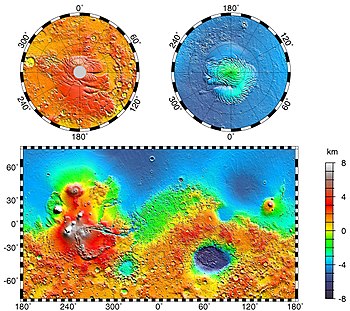

The Mars ocean theory states that nearly a third of the surface of Mars was covered by an ocean of liquid water early in the planet's geologic history.[2][3][4] This primordial ocean, dubbed Paleo-Ocean[1] or Oceanus Borealis (/oʊˈsiːənəs ˌbɒriˈælɪs/ oh-SEE-ə-nəs BORR-ee-AL-iss),[5] would have filled the basin Vastitas Borealis in the northern hemisphere, a region that lies 4–5 km (2.5–3 miles) below the mean planetary elevation, at a time period of approximately 4.1–3.8 billion years ago. Evidence for this ocean includes geographic features resembling ancient shorelines, and the chemical properties of the Martian soil and atmosphere.[6][7][8] Early Mars would have required a denser atmosphere and warmer climate to allow liquid water to remain at the surface.[9][10][11][12]
- ^ a b Brandenburg, John E. (1987). "The Paleo-Ocean of Mars". MECA Symposium on Mars: Evolution of its Climate and Atmosphere. Lunar and Planetary Institute. pp. 20–22. Bibcode:1987meca.symp...20B.
- ^ Cabrol, N. and E. Grin (eds.). 2010. Lakes on Mars. Elsevier. NY
- ^ Clifford, S. M.; Parker, T. J. (2001). "The Evolution of the Martian Hydrosphere: Implications for the Fate of a Primordial Ocean and the Current State of the Northern Plains". Icarus. 154 (1): 40–79. Bibcode:2001Icar..154...40C. doi:10.1006/icar.2001.6671. S2CID 13694518.
- ^ Rodriguez, J. Alexis P.; Kargel, Jeffrey S.; Baker, Victor R.; Gulick, Virginia C.; et al. (8 September 2015). "Martian outflow channels: How did their source aquifers form, and why did they drain so rapidly?". Scientific Reports. 5 (1): 13404. Bibcode:2015NatSR...513404R. doi:10.1038/srep13404. PMC 4562069. PMID 26346067.
- ^ Baker, V. R.; Strom, R. G.; Gulick, V. C.; Kargel, J. S.; Komatsu, G.; Kale, V. S. (1991). "Ancient oceans, ice sheets and the hydrological cycle on Mars". Nature. 352 (6336): 589–594. Bibcode:1991Natur.352..589B. doi:10.1038/352589a0. S2CID 4321529.
- ^ "Mars: The planet that lost an ocean's worth of water".
- ^ "NASA finds evidence of a vast ancient ocean on Mars". MSN.
- ^ Villanueva, G.; Mumma, M.; Novak, R.; Käufl, H.; Hartogh, P.; Encrenaz, T.; Tokunaga, A.; Khayat, A.; Smith, M. (2015). "Strong water isotopic anomalies in the martian atmosphere: Probing current and ancient reservoirs". Science. 348 (6231): 218–21. Bibcode:2015Sci...348..218V. doi:10.1126/science.aaa3630. PMID 25745065. S2CID 206633960.
- ^ Read, Peter L. and S. R. Lewis, "The Martian Climate Revisited: Atmosphere and Environment of a Desert Planet", Praxis, Chichester, UK, 2004.
- ^ Fairén, A. G. (2010). "A cold and wet Mars Mars". Icarus. 208 (1): 165–175. Bibcode:2010Icar..208..165F. doi:10.1016/j.icarus.2010.01.006.
- ^ Fairén, A. G.; et al. (2009). "Stability against freezing of aqueous solutions on early Mars". Nature. 459 (7245): 401–404. Bibcode:2009Natur.459..401F. doi:10.1038/nature07978. PMID 19458717. S2CID 205216655.
- ^ Fairén, A. G.; et al. (2011). "Cold glacial oceans would have inhibited phyllosilicate sedimentation on early Mars". Nature Geoscience. 4 (10): 667–670. Bibcode:2011NatGe...4..667F. doi:10.1038/ngeo1243.